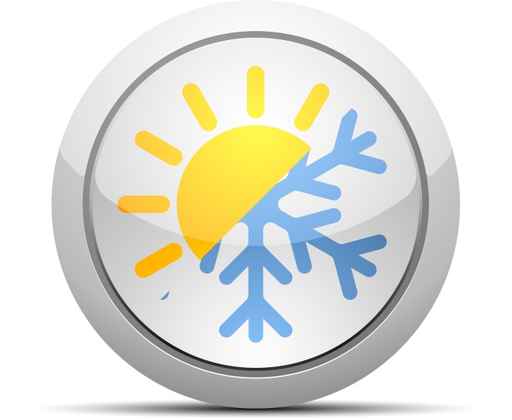
If you are a homeowner, energy efficiency in your home should be a priority. Not only is energy efficiency good for the environment, but it is also good for your budget. Did you know that on average, households in the U.S. spend over $2,200 per year on energy bills and that nearly half of this figure covers heating and cooling costs? You can drastically lower this figure by choosing energy efficient heating and cooling systems for your home.
The U.S. Environmental Protection Agency (EPA), as well as the U.S. Department of Energy provide numerous suggestions for how to save on energy costs for your home while also increasing your comfort and fighting global warming. Through Energy Star, the government supported program for energy efficiency, you can learn more about energy efficient practices and products in your home.
When is it Time to Make a Change?
There are many clues that will tell you when it is time to make a change in the way your home is heated and cooled. At the most basic level, your heating and cooling system should effectively control the temperature in your home at a reasonable cost.
- Is your home too hot or too cold? If yes, it is time to learn more about air sealing and insulation. If your home does not have adequate sealing and insulation, you will not be able to maintain a comfortable temperature. You will also force your heating and cooling system to work harder.
- Does your equipment need costly repairs? If your equipment constantly needs repairs and your energy bills are rising, it may be time for a new, more efficient system.
- Is your system updated? If your heating and cooling system is over 10 years old, it is unlikely that the system is as energy efficient as it could be. You can upgrade to a system with more energy saving options, such as a programmable thermostat.
- Are you using and spending more compared to others? To find out how your energy use and costs compare to other Americans, visit www.energystar.gov/yardstick. If your score is below 5, continue to www.energystar.gov/homeadvisor for recommendations to increase your efficiency.

Heating Systems
There are many different options for your heating system. The most efficient styles are central heating, water-based heaters, and resistance baseboard heaters. The U.S. Department of Energy provides extensive information on heating systems for your home.
- Furnaces: Furnaces are one of the most common ways to heat a home. They heat the air and distribute it throughout your home using ducts. Furnaces usually run on gas as well as oil, propane, or electricity. Search for a furnace that has earned the ENERGY STAR rating, meaning it has a higher Annual Fuel Utilization (AFUE) rating.
- Boilers: Boilers are another very common way to heat your home. They heat water, distributing it as steam through pipes, or as hot water through radiant floor systems or baseboard radiators. Boilers can also heat air through a coil. Steam boilers are less energy efficient than hot water boilers, but either type may have ENERGY STAR ratings, or a higher AFUE rating.
- Heat Pumps: Heat pumps are different because they provide both heating and cooling. They come in two versions: electric air-source heat pumps (ASHPs) and geothermal heat pumps (GHPs). ASHPs cool and heat, utilizing the difference in temperature between indoor and outdoor air. Find one that is ENERGY STAR qualified with higher SEER, EER, and HSPF ratings. GHPs use the ground instead of the air, and they are one of the most efficient and effective systems available. They are initially more expensive but will save you money in the long run.
- Solar: Active solar heating uses the sun to heat either liquid or air, and it is often used as a secondary system of heating in the home.
- Electric: Electric resistance heating is one of the most expensive ways to heat your home. If electricity is your only option, a heat pump is the preferable choice.
- Wood and Pellet: Wood and pellet burning is a way to heat your home that utilizes biomass or waste. They may emit air pollutants, and you should choose a system that is certified by the EPA.
- Radiators: Steam and hot water radiators deliver heat without ducts. Steam is a very old technology, while hot water is common in new homes.
- Radiant Heating: Radiant heating uses panels on the floor, wall, or ceiling to transfer heat. It is more efficient than baseboard or forced-air heating.
- Portable Heaters: Portable heaters are not as efficient as central heating, but if used appropriately, they can help you save.
Cooling Systems
There are also a variety of options for your home cooling system, and the U.S. Department of Energy provides much information on these systems. Air conditioning and swamp cooling are very efficient and effective systems.
- Ventilation and Fans: You can utilize natural ventilation and fans for added cooling in your home; however, a larger system, such as an air conditioning system, is usually necessary.
- Air Conditioning: You can use either central air conditioning or single air conditioners throughout your home. Air conditioning is very common, and it is easy to locate air conditioning systems with ENERGY STAR ratings, or higher SEER and EER ratings. These will save you money.
- Evaporative Cooling: Evaporative cooling, also known as swamp cooling, is utilized in dry climates. It is similar to air conditioning but is much more energy efficient.
- Radiant Cooling: Radiant cooling absorbs heat through the floor or ceiling, and it is generally only used in certain arid climates.
Services Offered By Albuquerque Plumbing, Heating & Cooling
Albuquerque Plumbing, Heating & Cooling can assist you in installing and servicing energy efficient heating and cooling systems. With over 50 years of combined experience, we are a trusted resource, whether you need to choose a new system, or simply need HVAC maintenance. Contact us to discuss your options for a more energy efficient home today.



